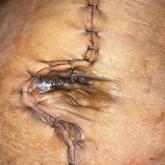Article

Growing Periumbilical Plaque: A Case of Perforating Calcific Elastosis
- Author:
- Courtney Kromer, MD, MS
- Emily Sedaghat, MD
- Harry Winfield, MD
Dermatologists should be aware of the importance of clinically differentiating PCE from pseudoxanthoma elasticum to prevent extensive workup,...
